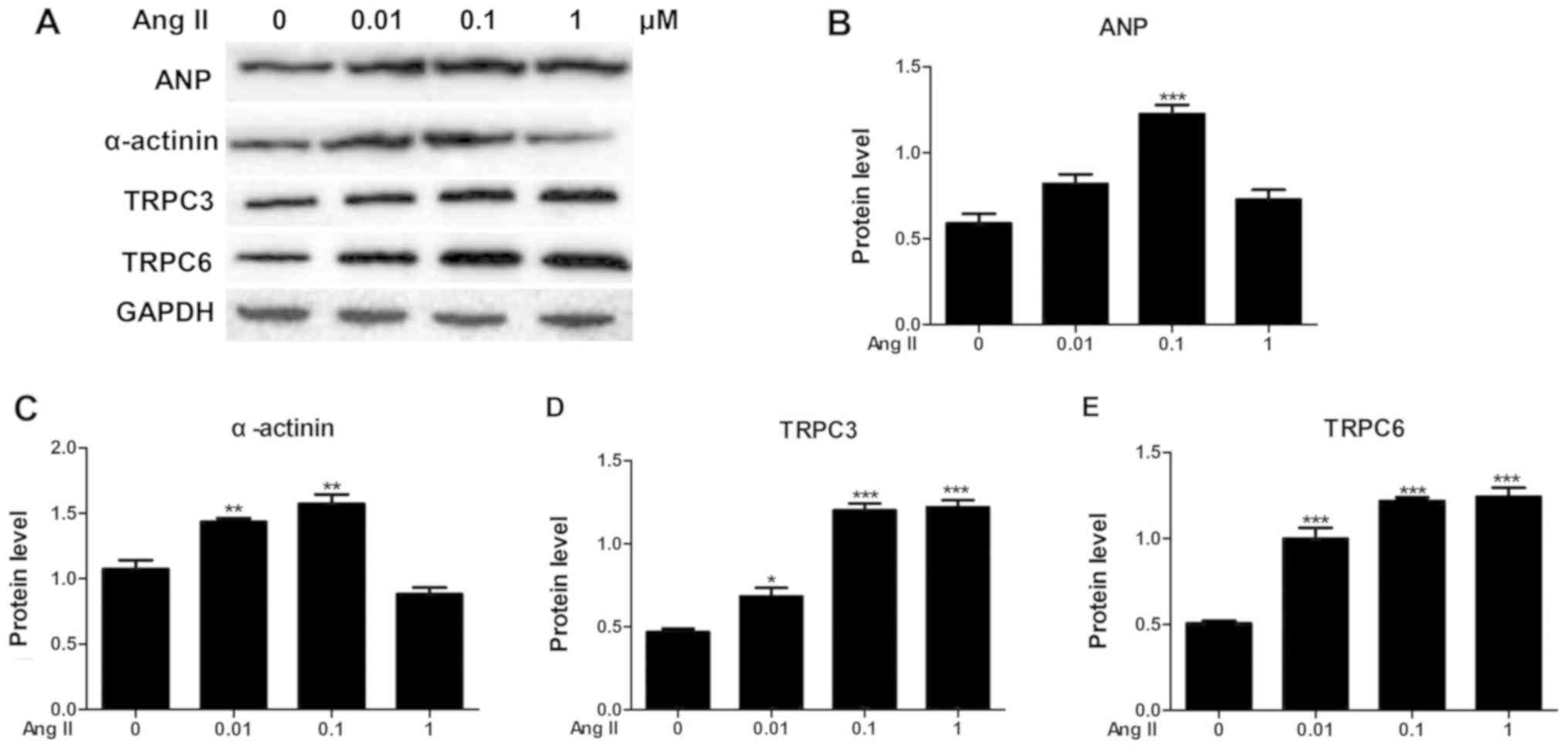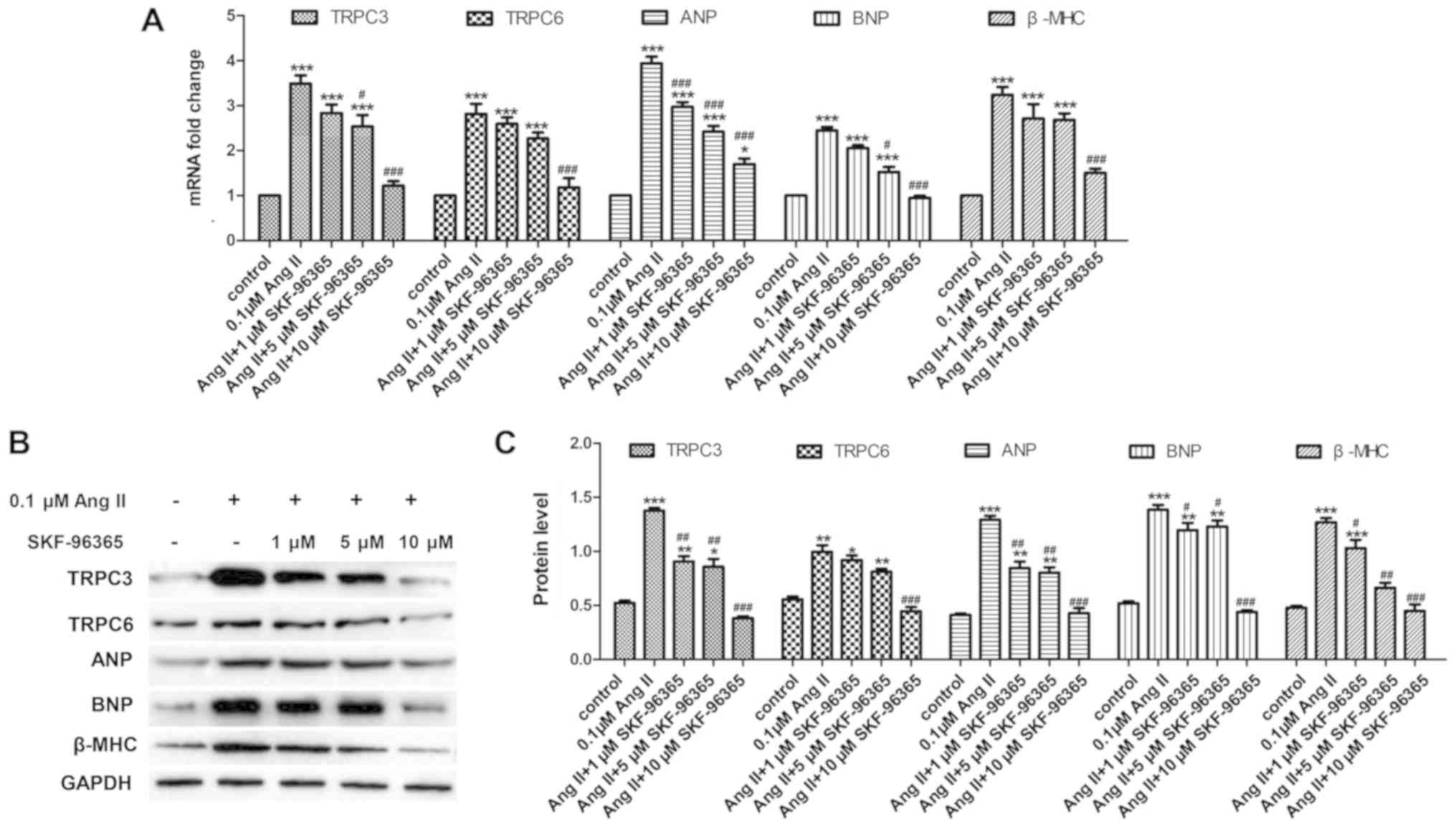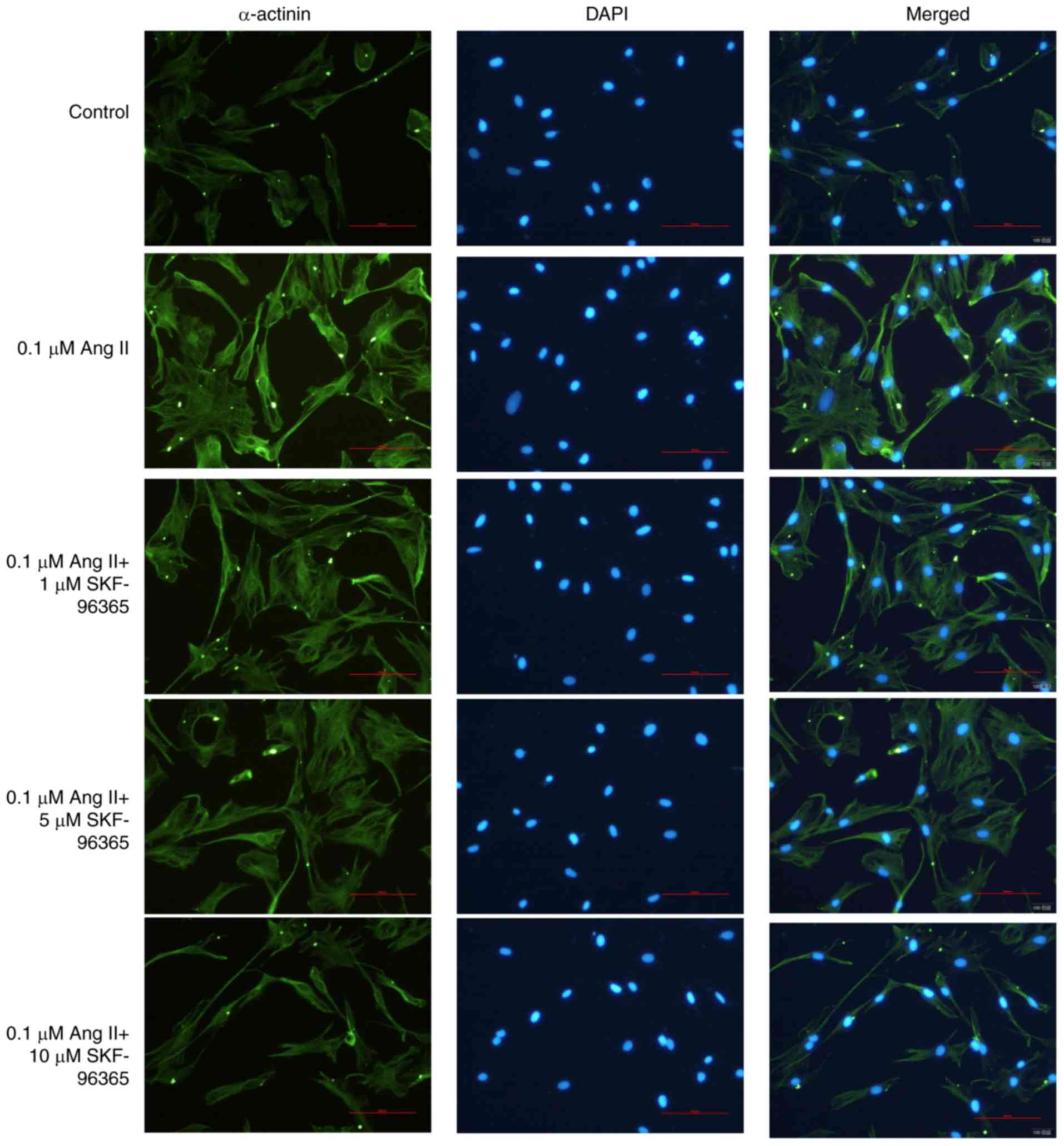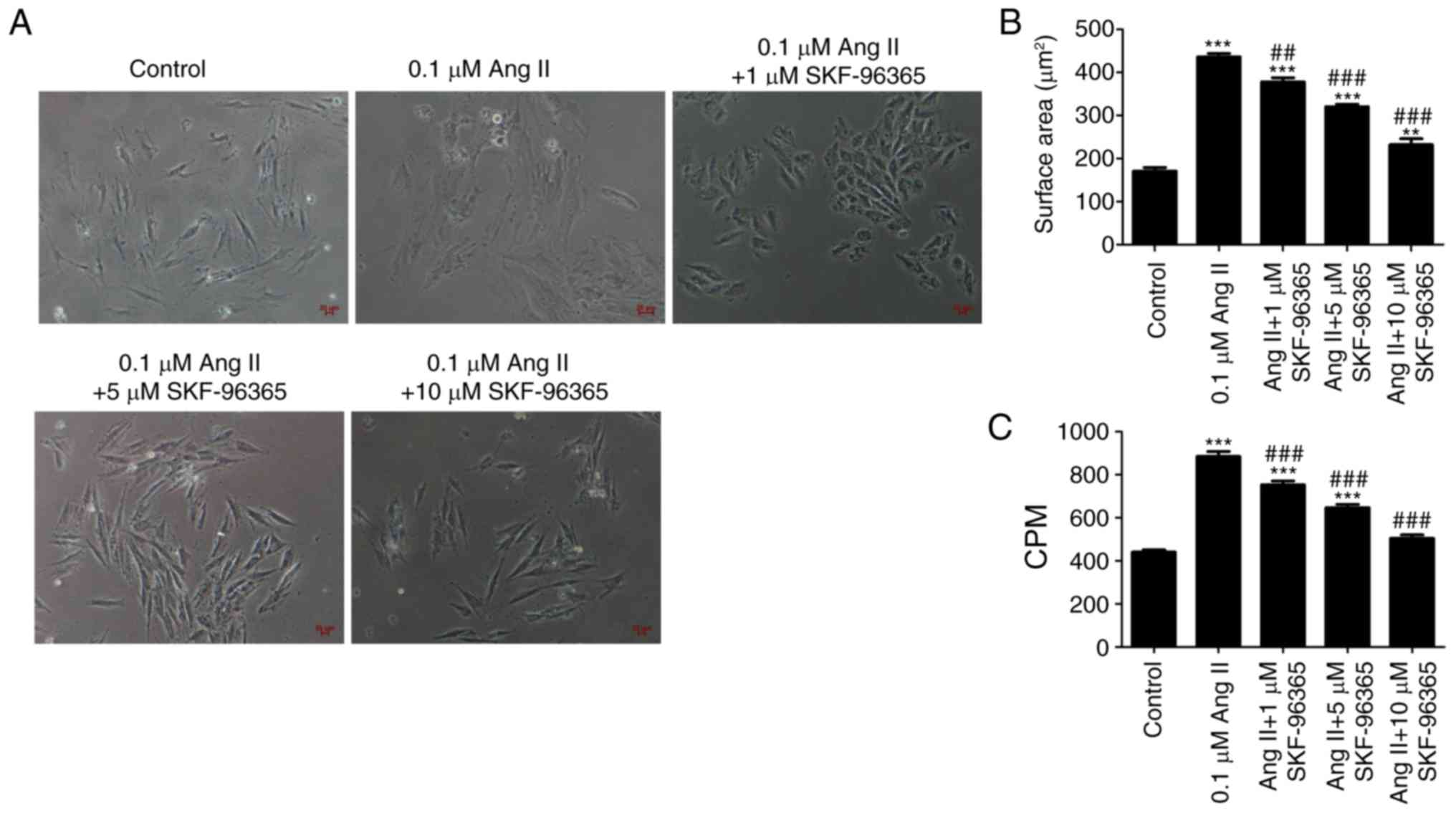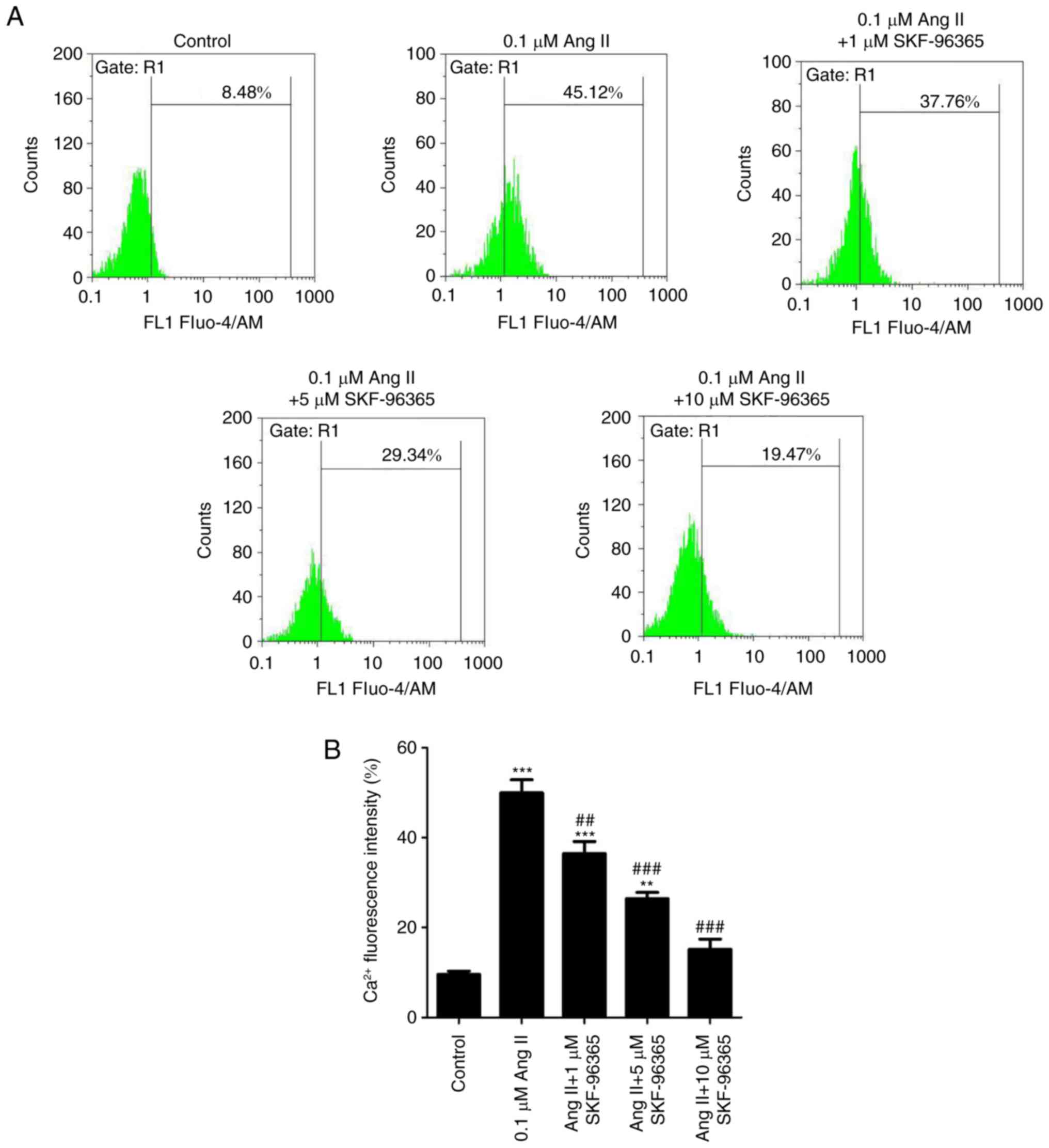|
1
|
Messerli FH, Aristizabal D and Soria F:
Reduction of left ventricular hypertrophy: How beneficial. Am Heart
J. 125:1520–1524. 1993. View Article : Google Scholar : PubMed/NCBI
|
|
2
|
Oka T, Akazawa H, Naito AT and Komuro I:
Angiogenesis and cardiac hypertrophy: Maintenance of cardiac
function and causative roles in heart failure. Circ Res.
114:565–571. 2014. View Article : Google Scholar : PubMed/NCBI
|
|
3
|
Ito M, Oliverio MI, Mannon PJ, Best CF,
Maeda N, Smithies O and Coffman TM: Regulation of blood pressure by
the type 1A angiotensin II receptor gene. Proc Natl Acad Sci USA.
92:3521–3525. 1995. View Article : Google Scholar : PubMed/NCBI
|
|
4
|
Sadoshima J, Xu Y, Slayter HS and Izumo S:
Autocrine release of angiotensin II mediates stretch-induced
hypertrophy of cardiac myocytes in vitro. Cell. 75:977–984. 1993.
View Article : Google Scholar : PubMed/NCBI
|
|
5
|
Kim S, Ohta K, Hamaguchi A, Yukimura T,
Miura K and Iwao H: Angiotensin II induces cardiac phenotypic
modulation and remodeling in vivo in rats. Hypertension.
25:1252–1259. 1995. View Article : Google Scholar : PubMed/NCBI
|
|
6
|
Mollmann H, Schmidt-Schweda S, Nef H,
Möllmann S, Burstin JV, Klose S, Elsässer A and Holubarsch CJ:
Contractile effects of angiotensin and endothelin in failing and
non-failing human hearts. Int J Cardiol. 114:34–40. 2007.
View Article : Google Scholar : PubMed/NCBI
|
|
7
|
Fabris B, Candido R, Bortoletto M,
Zentilin L, Sandri M, Fior F, Toffoli B, Stebel M, Bardelli M,
Belgrado D, et al: Dose and time-dependent apoptotic effects by
angiotensin II infusion on left ventricular cardiomyocytes. J
Hypertens. 25:1481–1490. 2007. View Article : Google Scholar : PubMed/NCBI
|
|
8
|
Guo H, Liu B, Hou L, The E, Li G, Wang D,
Jie Q, Che W and Wei Y: The role of mAKAPβ in the process of
cardiomyocyte hypertrophy induced by angiotensin II. Int J Mol Med.
35:1159–1168. 2015. View Article : Google Scholar : PubMed/NCBI
|
|
9
|
Bai Y, Sun X, Chu Q, Li A, Qin Y, Li Y,
Yue E, Wang H, Li G, Zahra SM, et al: Caspase-1 regulates Ang
II-induced cardiomyocyte hypertrophy via up-regulation of IL-1β.
Biosci Rep. Apr 27–2018.(Epub ahead of print). View Article : Google Scholar
|
|
10
|
Kimes BW and Brandt BL: Properties of a
clonal muscle cell line from rat heart. Exp Cell Res. 98:367–381.
1976. View Article : Google Scholar : PubMed/NCBI
|
|
11
|
Cosens DJ and Manning A: Abnormal
electroretinogram from a Drosophila mutant. Nature.
224:285–287. 1969. View
Article : Google Scholar : PubMed/NCBI
|
|
12
|
Pak WL, Grossfield J and Arnold KS:
Mutants of the visual pathway of Drosophila melanogaster.
Nature. 227:518–520. 1970. View
Article : Google Scholar : PubMed/NCBI
|
|
13
|
Hotta Y and Benzer S: Genetic dissection
of the Drosophila nervous system by means of mosaics. Proc
Natl Acad Sci USA. 67:1156–1163. 1970. View Article : Google Scholar : PubMed/NCBI
|
|
14
|
Nilius B and Szallasi A: Transient
receptor potential channels as drug targets: From the science of
basic research to the art of medicine. Pharmacol Rev. 66:676–814.
2014. View Article : Google Scholar : PubMed/NCBI
|
|
15
|
Montell C, Birnbaumer L, Flockerzi V,
Bindels RJ, Bruford EA, Caterina MJ, Clapham DE, Harteneck C,
Heller S, Julius D, et al: A unified nomenclature for the
superfamily of TRP cation channels. Mol Cell. 9:229–231. 2002.
View Article : Google Scholar : PubMed/NCBI
|
|
16
|
Jiang Y, Huang H, Liu P, Wei H, Zhao H,
Feng Y, Wang W and Niu W: Expression and localization of TRPC
proteins in rat ventricular myocytes at various developmental
stages. Cell Tissue Res. 355:201–212. 2014. View Article : Google Scholar : PubMed/NCBI
|
|
17
|
Mu YP, Lin DC, Yan FR, Jiao HX, Gui LX and
Lin MJ: Alterations in caveolin-1 expression and receptor-operated
Ca2+ entry in the aortas of rats with pulmonary hypertension. Cell
Physiol Biochem. 39:438–452. 2016. View Article : Google Scholar : PubMed/NCBI
|
|
18
|
Huynh KW, Cohen MR, Chakrapani S, Holdaway
HA, Stewart PL and Moiseenkova-Bell VY: Structural insight into the
assembly of TRPV channels. Structure. 22:260–268. 2014. View Article : Google Scholar : PubMed/NCBI
|
|
19
|
Tai Y, Yang S, Liu Y and Shao W: TRPC
Channels in Health and Disease. Adv Exp Med Biol. 976:35–45. 2017.
View Article : Google Scholar : PubMed/NCBI
|
|
20
|
Kwon J, An H, Sa M, Won J, Shin JI and Lee
CJ: Orai1 and orai3 in combination with stim1 mediate the majority
of store-operated calcium entry in astrocytes. Exp Neurobiol.
26:42–54. 2017. View Article : Google Scholar : PubMed/NCBI
|
|
21
|
Li N, Si B, Ju JF, Zhu M, You F, Wang D,
Ren J, Ning YS, Zhang FQ, Dong K, et al: Nicotine induces
cardiomyocyte hypertrophy through trpc3-mediated Ca2+
NFAT signalling pathway. Can J Cardiol. 32:1260.e1–1260.e10. 2016.
View Article : Google Scholar
|
|
22
|
Antigny F, Sabourin J, Sauc S, Bernheim L,
Koenig S and Frieden M: TRPC1 and TRPC4 channels functionally
interact with STIM1L to promote myogenesis and maintain fast
repetitive Ca2+ release in human myotubes. Biochim
Biophys Acta Mol Cell Res. 1864:806–813. 2017. View Article : Google Scholar : PubMed/NCBI
|
|
23
|
Ambudkar IS, de Souza LB and Ong HL:
TRPC1, Orai1, and STIM1 in SOCE: Friends in tight spaces. Cell
Calcium. 63:33–39. 2017. View Article : Google Scholar : PubMed/NCBI
|
|
24
|
Pecoraro M, Pinto A and Popolo A:
Mitochondria and cardiovascular disease: A Brief Account. Crit Rev
Eukaryot Gene Expr. 29:295–304. 2019. View Article : Google Scholar : PubMed/NCBI
|
|
25
|
Yue Z, Xie J, Yu AS, Stock J, Du J and Yue
L: Role of TRP channels in the cardiovascular system. Am J Physiol
Heart Circ Physiol. 308:H157–182. 2015. View Article : Google Scholar : PubMed/NCBI
|
|
26
|
Eder P: Cardiac Remodeling and Disease:
SOCE and TRPC Signaling in Cardiac Pathology. Adv Exp Med Biol.
993:505–521. 2017. View Article : Google Scholar : PubMed/NCBI
|
|
27
|
Falcón D, Galeano-Otero I,
Calderón-Sánchez E, Del Toro R, Martín-Bórnez M, Rosado JA, Hmadcha
A and Smani T: TRP Channels: Current perspectives in the adverse
cardiac remodeling. Front Physiol. 10:1592019. View Article : Google Scholar : PubMed/NCBI
|
|
28
|
Ohba T, Watanabe H, Murakami M, Takahashi
Y, Iino K, Kuromitsu S, Mori Y, Ono K, Iijima T and Ito H:
Upregulation of TRPC1 in the development of cardiac hypertrophy. J
Mol Cell Cardiol. 42:498–507. 2007. View Article : Google Scholar : PubMed/NCBI
|
|
29
|
Sunggip C, Shimoda K, Oda S, Tanaka T,
Nishiyama K, Mangmool S, Nishimura A, Numaga-Tomita T and Nishida
M: TRPC5-eNOS axis negatively regulates ATP-induced cardiomyocyte
hypertrophy. Front Pharmacol. 9:5232018. View Article : Google Scholar : PubMed/NCBI
|
|
30
|
Kuwahara K, Wang Y, McAnally J, Richardson
JA, Bassel-Duby R, Hill JA and Olson EN: TRPC6 fulfills a
calcineurin signaling circuit during pathologic cardiac remodeling.
J Clin Invest. 116:3114–3126. 2006. View Article : Google Scholar : PubMed/NCBI
|
|
31
|
Satoh S, Tanaka H, Ueda Y, Oyama J, Sugano
M, Sumimoto H, Mori Y and Makino N: Transient receptor potential
(TRP) protein 7 acts as a G protein-activated Ca2+ channel
mediating angiotensin II-induced myocardial apoptosis. Mol Cell
Biochem. 294:205–215. 2007. View Article : Google Scholar : PubMed/NCBI
|
|
32
|
Lyon RC, Zanella F, Omens JH and Sheikh F:
Mechanotransduction in cardiac hypertrophy and failure. Circ Res.
116:1462–1476. 2015. View Article : Google Scholar : PubMed/NCBI
|
|
33
|
Hou J and Kang YJ: Regression of
pathological cardiac hypertrophy: Signaling pathways and
therapeutic targets. Pharmacol Ther. 135:337–354. 2012. View Article : Google Scholar : PubMed/NCBI
|
|
34
|
Li H: TRP Channel Classification. Adv Exp
Med Biol. 976:1–8. 2017. View Article : Google Scholar : PubMed/NCBI
|
|
35
|
Sawamura S, Shirakawa H, Nakagawa T, Mori
Y and Kaneko S: Frontiers in Neuroscience TRP Channels in the
Brain: What Are They There For? Neurobiology of TRP Channels. Emir
TLR: 2nd. CRC Press/Taylor & Francis; Boca Raton, FL: pp.
295–322. 2017, View Article : Google Scholar
|
|
36
|
Caterina MJ and Pang Z: TRP Channels in
Skin Biology and Pathophysiology. Pharmaceuticals (Basel). 9(pii):
E772016. View Article : Google Scholar : PubMed/NCBI
|
|
37
|
Pedersen SF, Owsianik G and Nilius B: TRP
channels: An overview. Cell Calcium. 38:233–252. 2005. View Article : Google Scholar : PubMed/NCBI
|
|
38
|
Lee HC, Yoon SY, Lykke-Hartmann K, Fissore
RA and Carvacho I: TRPV3 channels mediate Ca2+ influx
induced by 2-APB in mouse eggs. Cell Calcium. 59:21–31. 2016.
View Article : Google Scholar : PubMed/NCBI
|
|
39
|
El Boustany C, Bidaux G, Enfissi A,
Delcourt P, Prevarskaya N and Capiod T: Capacitative calcium entry
and transient receptor potential canonical 6 expression control
human hepatoma cell proliferation. Hepatology. 47:2068–2077. 2008.
View Article : Google Scholar : PubMed/NCBI
|
|
40
|
Song MY and Yuan JX: Introduction to TRP
channels: Structure, function, and regulation. Adv Exp Med Biol.
661:99–108. 2010. View Article : Google Scholar : PubMed/NCBI
|
|
41
|
Greka A, Navarro B, Oancea E, Duggan A and
Clapham DE: TRPC5 is a regulator of hippocampal neurite length and
growth cone morphology. Nat Neurosci. 6:837–845. 2003. View Article : Google Scholar : PubMed/NCBI
|
|
42
|
Lepage PK and Boulay G: Molecular
determinants of TRP channel assembly. Biochem Soc Trans. 35:81–83.
2007. View Article : Google Scholar : PubMed/NCBI
|
|
43
|
Qi H, Ren J, E M, Zhang Q, Cao Y, Ba L,
Song C, Shi P, Fu B and Sun H: MiR-103 inhibiting cardiac
hypertrophy through inactivation of myocardial cell autophagy via
targeting TRPV3 channel in rat hearts. J Cell Mol Med.
23:1926–1939. 2019. View Article : Google Scholar : PubMed/NCBI
|
|
44
|
Wang Z, Xu Y, Wang M, Ye J, Liu J, Jiang
H, Ye D and Wan J: TRPA1 inhibition ameliorates pressure
overload-induced cardiac hypertrophy and fibrosis in mice.
EBioMedicine. 36:54–62. 2018. View Article : Google Scholar : PubMed/NCBI
|
|
45
|
Seth M, Zhang ZS, Mao L, Graham V, Burch
J, Stiber J, Tsiokas L, Winn M, Abramowitz J, Rockman HA, et al:
TRPC1 channels are critical for hypertrophic signaling in the
heart. Circ Res. 105:1023–1030. 2009. View Article : Google Scholar : PubMed/NCBI
|
|
46
|
Kinoshita H, Kuwahara K, Nishida M, Jian
Z, Rong X, Kiyonaka S, Kuwabara Y, Kurose H, Inoue R, Mori Y, et
al: Inhibition of TRPC6 channel activity contributes to the
antihypertrophic effects of natriuretic peptides-guanylyl cyclase-A
signaling in the heart. Circ Res. 106:1849–1860. 2010. View Article : Google Scholar : PubMed/NCBI
|
|
47
|
Watanabe H, Iino K, Ohba T and Ito H:
Possible involvement of TRP channels in cardiac hypertrophy and
arrhythmia. Curr Top Med Chem. 13:283–294. 2013. View Article : Google Scholar : PubMed/NCBI
|
|
48
|
Eder P and Molkentin JD: TRPC channels as
effectors of cardiac hypertrophy. Circ Res. 108:265–272. 2011.
View Article : Google Scholar : PubMed/NCBI
|
|
49
|
Ding J, Xiao Y, Lu D, Du YR, Cui XY and
Chen J: Effects of SKF-96365, a TRPC inhibitor, on melittin-induced
inward current and intracellular Ca2+ rise in primary sensory
cells. Neurosci Bull. 27:135–142. 2011. View Article : Google Scholar : PubMed/NCBI
|
|
50
|
Merritt JE, Armstrong WP, Benham CD,
Hallam TJ, Jacob R, Jaxa-Chamiec A, Leigh BK, McCarthy SA, Moores
KE and Rink TJ: SK&F 96365, a novel inhibitor of
receptor-mediated calcium entry. Biochem J. 271:515–522. 1990.
View Article : Google Scholar : PubMed/NCBI
|
|
51
|
Chen KH, Liu H, Yang L, Jin MW and Li GR:
SKF-96365 strongly inhibits voltage-gated sodium current in rat
ventricular myocytes. Pflugers Arch. 467:1227–1236. 2015.
View Article : Google Scholar : PubMed/NCBI
|
|
52
|
Hartman JC: The role of bradykinin and
nitric oxide in the cardioprotective action of ACE inhibitors. Ann
Thorac Surg. 60:789–792. 1995. View Article : Google Scholar : PubMed/NCBI
|
|
53
|
Weber KT, Brilla CG and Janicki JS:
Myocardial fibrosis: Functional significance and regulatory
factors. Cardiovasc Res. 27:341–348. 1993. View Article : Google Scholar : PubMed/NCBI
|
|
54
|
Rohini A, Agrawal N, Koyani CN and Singh
R: Molecular targets and regulators of cardiac hypertrophy.
Pharmacol Res. 61:269–280. 2010. View Article : Google Scholar : PubMed/NCBI
|
|
55
|
Onohara N, Nishida M, Inoue R, Kobayashi
H, Sumimoto H, Sato Y, Mori Y, Nagao T and Kurose H: TRPC3 and
TRPC6 are essential for angiotensin II-induced cardiac hypertrophy.
EMBO J. 25:5305–5316. 2006. View Article : Google Scholar : PubMed/NCBI
|
|
56
|
Harada M, Luo X, Qi XY, Tadevosyan A,
Maguy A, Ordog B, Ledoux J, Kato T, Naud P, Voigt N, et al:
Transient receptor potential canonical-3 channel-dependent
fibroblast regulation in atrial fibrillation. Circulation.
126:2051–2064. 2012. View Article : Google Scholar : PubMed/NCBI
|
|
57
|
Gao H, Wang F, Wang W, Makarewich CA,
Zhang H, Kubo H, Berretta RM, Barr LA, Molkentin JD and Houser SR:
Ca(2+) influx through L-type Ca(2+) channels and transient receptor
potential channels activates pathological hypertrophy signaling. J
Mol Cell Cardiol. 53:657–667. 2012. View Article : Google Scholar : PubMed/NCBI
|
|
58
|
Singh A, Hildebrand ME, Garcia E and
Snutch TP: The transient receptor potential channel antagonist
SKF96365 is a potent blocker of low-voltage-activated T-type
calcium channels. Br J Pharmacol. 160:1464–1475. 2010. View Article : Google Scholar : PubMed/NCBI
|















